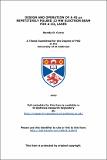Files in this item
Design and operation of a 45 μs repetitively pulsed 12 mw electron beam for a CO₂ laser
Item metadata
| dc.contributor.advisor | Maitland, Arthur | |
| dc.contributor.author | Curry, Randy D. | |
| dc.coverage.spatial | 219 p. | en_US |
| dc.date.accessioned | 2017-06-09T12:05:14Z | |
| dc.date.available | 2017-06-09T12:05:14Z | |
| dc.date.issued | 1992 | |
| dc.identifier | uk.bl.ethos.661138 | |
| dc.identifier.uri | https://hdl.handle.net/10023/10972 | |
| dc.description.abstract | The parameter space over which electron beams operate for pumping CO₂ lasers significantly extended. A repetitive pulsed power/electron beam system for the generation of 45 µs, 220 keV, electron beams for CO₂ lasers has been designed and implemented which can operate over a 6:1 impedance range. The system consists of a 150 kV – 250 kV modulator and a large area, (2.500 cm²) 5-20 mλ /cm² hot-cathode electron-beam gun. The system is designed and fabricated to be used in conjunction with an electron beam sustained laser and is capable of operating continuously at up to 10 pps. The following thesis examines, in detail, the experimental and theoretical investigation of the modulator/electron beam subsystems which comprise the electron beam system. Parameters of the CO₂ laser which determine the electron beam parameter space, and thus the modulator characteristics, are reviewed. Both cold-cathode and hot-cathode pulsed current parameters are reviewed, and the cathode characteristics upon which the hot-cathode was selected are discussed. The 132 thoriated tungsten filament, grid-controlled, hot-cathode gun used to generate the required 5-20 mλ/cm², 250 cm length source of electron beam with a spatial flatness of ± 10% is shown. Based on the hot-cathode electron beam gun design, the theoretical and practical design characteristics of the hollow-cathode, thyratron switched, 1800 J, 10 pps, 250 kV modulator are shown. Design equations which allow selection of the modulator operation range, and selection of the modulator matching resistors used to match the fixed impedance modulator to the 6:1 electron beam impedance range with a pulse droop of less then 0.7% and a pulse flatness of ± 10% are derived. Moreover, a detailed discussion of the circuit simulations used to both tune and optimize the modulator's impedance tapered, Transformer-coupled Type E PFN to the four electron beam operating ranges are shown. Practical layout and design and the grounding and shielding principles employed in the system. Component spacings required to insure reliable modulator operation at 250kV are also considered. The design and implementation of the 45 µs, SCR switched, transformer-coupled PFN based grid-pulser are discussed. The grid pulser characteristics including the 105-650 V, 28-166 A, pulse required to control the 5-20 mλ / cm²,hot-cathode current density are examined. Theoretical design equations are derived to allow, the Miller capacitance, and thus the time varying impedance of the grid-cathode region to be predicted. Circuit simulations showing the grid-pulser circuit interaction with the constant perveance, Miller capacitance dominated, grid-cathode load are discussed. Final layout of the SCR-switched, grid-pulser including design of the spiral inductors used for the PFN is reported. Specific layout details are shown which allow the grid pulser to operate reliably while floating at the 220 kV electron beam acceleration pulse. A discussion of the subsystem experimental integration phase conducted at Pulse Sciences, Inc. is also presented in the following thesis. Test results of the modulator and grid-pulser into their respective electron beam loads are compared with the circuit simulations. Relevant vacuum flashover physics issues found during the experimental integration of the modulator, grid-pulser, and electron-beam gun are considered. Specific discussions of the vacuum, gap and vacuum insulator physics which effect the operation of the large area electron beam gun are reported. Included in this discussion is the experimental cold- cathode conditioning procedure used to condition the electron-beam gun to 250 kV. In-situ, hot-cathode filament carburization and activation procedures developed during the integration phase of the program are also presented, with a short discussion of the background mass spectra measured during the experiments. Finally, the experimental characterization. of the spatial uniformity of the electron beam is reported along with a short summary of the investigation results. | en_US |
| dc.language.iso | en | en_US |
| dc.publisher | University of St Andrews | |
| dc.subject.lcc | TK7872.L3C8 | |
| dc.subject.lcsh | Lasers | en |
| dc.title | Design and operation of a 45 μs repetitively pulsed 12 mw electron beam for a CO₂ laser | en_US |
| dc.type | Thesis | en_US |
| dc.type.qualificationlevel | Doctoral | en_US |
| dc.type.qualificationname | PhD Doctor of Philosophy | en_US |
| dc.publisher.institution | The University of St Andrews | en_US |
This item appears in the following Collection(s)
Items in the St Andrews Research Repository are protected by copyright, with all rights reserved, unless otherwise indicated.

